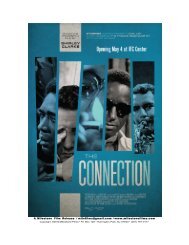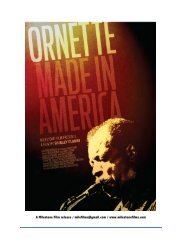A previously unpublished photo of a young <strong>Shirley</strong> <strong>Clarke</strong> dancing at the University of North Carolina. Courtesy of Wendy <strong>Clarke</strong>. However, by the early 1950s, with a young daughter and an aging body, <strong>Clarke</strong> decided to try filmmaking. The Brimberg family had always had a motion picture camera — there are home movies dating back to the early 1920s — and <strong>Shirley</strong> had received a 16mm camera as a wedding present. “Most of the dance films I’d seen were awful and I figured I could do better. Essentially, film’s a choreographic medium.” — Los Angeles Times interview, 1976 <strong>Shirley</strong> <strong>Clarke</strong> started out with what she knew best — dance and movement — and she quickly became an esteemed filmmaker at a time when only a handful of women worked in the field. (There were Mary Ellen Bute, Maya Deren, Ida Lupino and Helen Levitt to name a few.) She studied filmmaking with Hans Richter at the City College of New York, and made her first film, an adaptation of Daniel Nagrin’s ballet Dance in the Sun, in 1953. The film featured fluid intercuts from interior and exterior locations and did not (as dance films traditionally had) cut between long shots and close–ups of the dancers, which <strong>Clarke</strong> believed broke up the original patterns of expression in the choreography. She believed that “dance as it existed on the stage had to be destroyed in order to have a good film and not just a rather poor document.” (From Gretchen Berg’s “Interview with <strong>Shirley</strong> <strong>Clarke</strong>,” Film Culture, no. 44, Spring 1967: 52.) <strong>Clarke</strong>’s conversations with fellow dancer and filmmaker Maya Deren encouraged her to further her progress. There was a love–hate relationship between the two women
pioneer filmmakers (Deren reportedly invited <strong>Clarke</strong> to come to her apartment to view Deren’s films — and then charged her admission), but Deren inspired <strong>Clarke</strong> to see natural human movement as a form of dance as pure as the abstract movements she had previously been filming. Dance, in Deren’s interpretation, was an extension of the human consciousness in planes not “anchored in conventional spatiotemporal logic.” <strong>Clarke</strong>’s In Paris Parks (1954) manifested this concept, although its style differed greatly from Deren’s because of its disregard for a rigid structure of motion and because of its upbeat jazz music, which reflected the idea of abstract movement itself. <strong>Clarke</strong> would later go on to further include jazz, which itself challenged traditional values in music, in almost all her soundtracks. She definitely aimed to challenge established values in cinema in her own work. In Paris Parks is one of her finest early films and it all started by accident. <strong>Clarke</strong> had traveled to Paris to make a film about the famed mime Étienne DeCroux. She arrived with her camera, her equipment and her daughter Wendy in tow, only to find that he had gone off to Italy. She was in a fury, but with nothing to do, she found herself taking Wendy to the park. On the second day, she realized that the playing of the children was in itself a dance. So she made “a dance of life.” <strong>Clarke</strong> returned to New York to become a full–time filmmaker, enrolling in the City College of New York’s film program. She joined the Independent Film Maker’s Association and entered her dance films into competitions. Her third film, Bullfight, is the only filmed performance of the legendary choreographer Anna Sokolow. Its success, winning awards at the 1955 Edinburgh and Venice Film Festivals, along with awards for her other short films, solidified <strong>Clarke</strong>’s career. By 1958, <strong>Clarke</strong> had become a leading figure in the world of avant–garde film. Her 1957 film, A Moment in Love was named one of the ten best nontheatrical films of the year by The New York Times. <strong>Clarke</strong> was also chosen, along with other filmmakers, to create short film loops depicting scenes of American life for the United States Pavilion at the 1958 Brussels World’s Fair. She became known as an advocate for the small independent film community in New York, and soon after began to turn towards social issues in her filmmaking. In 1958, she, Irving Jacoby and Willard van Dyke started a short film on 666 Fifth Avenue (known as the Tishman Building), then a year under construction. Working in 35mm for the first time, she called it “a musical comedy about the building of a skyscraper.” They received an Academy Award nomination for Skyscraper (1960). As her fame grew, so did her ambition. <strong>Clarke</strong> was now a vital part of the burgeoning post–war American film movement. She was one of the first— and the only woman — signers of the New American Cinema manifesto in 1961. She, like many of her contemporaries, was influenced by the works of Lionel Rogosin (On the Bowery), James Agee (The Quiet One), Helen Leavitt (In the Street), Roberto Rossellini (especially Open City) and the cinema vérité filmmakers. <strong>Clarke</strong>’s sister Elaine (married to critic Kenneth Tynan and a noted author in her own right) wrote in her autobiography that she was the first to suggest to <strong>Shirley</strong> that she consider a play by a friend of hers, Jack Gelber, for her first feature. Controversial from the start, “The Connection” had opened to negative reviews, but within a few months,




